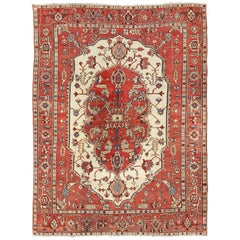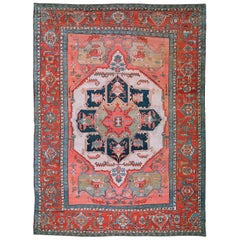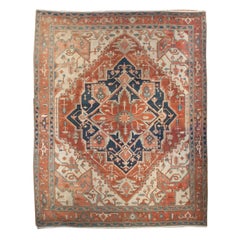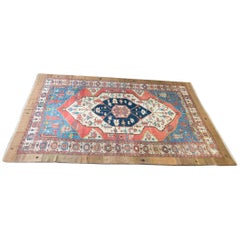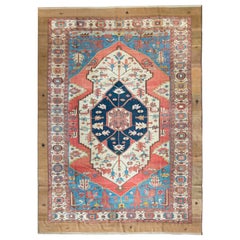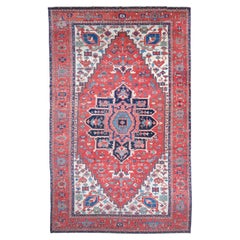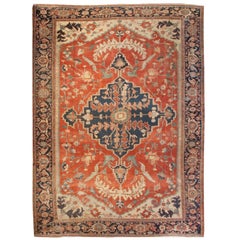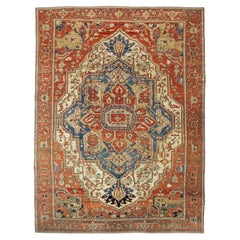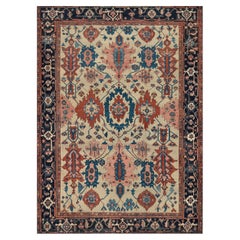19th Century Serapi
Antique 1880s Persian Heriz Serapi Persian Rugs
Wool
Antique 19th Century Persian American Classical Persian Rugs
Wool
Antique 1880s Asian Serapi Persian Rugs
Wool
Antique 1880s Persian Serapi Persian Rugs
Wool
Antique 1880s Persian Serapi Persian Rugs
Wool
Antique Late 19th Century Persian Persian Rugs
Wool
Antique 1870s Asian Serapi Persian Rugs
Wool
Antique Late 19th Century Persian Heriz Serapi Persian Rugs
Wool, Cotton
Antique Late 19th Century Persian Serapi Persian Rugs
Wool
Antique 19th Century Persian Persian Rugs
Wool
Antique Late 19th Century Persian Serapi Persian Rugs
Wool
Antique Late 19th Century Persian Serapi Persian Rugs
Wool
Antique Late 19th Century Persian Serapi Persian Rugs
Wool
Antique Late 19th Century Persian Serapi Persian Rugs
Wool
Antique Late 19th Century Persian Serapi Persian Rugs
Wool
Antique 1870s Persian Serapi Persian Rugs
Wool
Antique 19th Century Persian Serapi Persian Rugs
Wool
Antique Late 19th Century Persian Persian Rugs
Wool
Antique 1880s Central Asian Serapi Central Asian Rugs
Wool
Antique 19th Century Persian Serapi Persian Rugs
Wool
Antique 19th Century Persian Persian Rugs
Wool
Early 20th Century Persian Heriz Serapi Persian Rugs
Wool
Antique Late 19th Century Persian Serapi Persian Rugs
Wool
Early 20th Century Persian Heriz Serapi Persian Rugs
Wool
Antique Late 19th Century Persian Serapi Persian Rugs
Wool
Antique Late 19th Century Persian Heriz Serapi Persian Rugs
Wool
Antique Late 19th Century Persian Heriz Serapi Persian Rugs
Wool
Antique Late 19th Century Persian Serapi Persian Rugs
Wool
Antique Late 19th Century Persian Serapi Persian Rugs
Wool
Antique Late 19th Century Persian Heriz Serapi Persian Rugs
Wool
Antique Late 19th Century Persian Serapi Persian Rugs
Wool
Antique Late 19th Century Persian Heriz Serapi Persian Rugs
Wool
Antique Late 19th Century Turkish Turkish Rugs
Wool, Cotton
Antique Late 19th Century Persian Serapi Persian Rugs
Wool
Antique Late 19th Century Persian Serapi Persian Rugs
Wool
Antique 19th Century Persian American Classical Persian Rugs
Wool
Antique 19th Century Persian Persian Rugs
Wool
Antique Late 19th Century Persian Serapi Persian Rugs
Wool
Antique Late 19th Century Persian Serapi Persian Rugs
Wool
Antique Mid-19th Century Persian Heriz Serapi Persian Rugs
Wool
Antique Late 19th Century Persian Serapi Persian Rugs
Wool
Antique Late 19th Century Persian Persian Rugs
Wool
Antique Early 19th Century Persian Serapi Persian Rugs
Wool
Antique 1880s Persian Persian Rugs
Wool
Antique Late 19th Century Heriz Serapi Persian Rugs
Wool
Antique Late 19th Century Persian Persian Rugs
Wool
Antique 19th Century Persian Persian Rugs
Wool
Antique Late 19th Century Persian Serapi Persian Rugs
Wool
Antique Late 19th Century Persian Heriz Serapi Persian Rugs
Wool
Antique Late 19th Century Persian Persian Rugs
Wool
Antique Late 19th Century Persian Serapi Persian Rugs
Wool
Antique 1880s Persian Serapi Persian Rugs
Wool
Antique Late 19th Century Persian Serapi Persian Rugs
Wool
Antique Late 19th Century Persian Serapi Persian Rugs
Wool
Antique 1860s Persian Serapi Persian Rugs
Wool
Antique 1880s Persian Bakshaish Persian Rugs
Wool
Antique Late 19th Century Persian Serapi Persian Rugs
Wool
Antique 1880s Persian Islamic Persian Rugs
Wool
Antique 19th Century Azerbaijani Heriz Serapi Persian Rugs
Wool
Antique 1880s Persian Tabriz Persian Rugs
Wool, Cotton
- 1
19th Century Serapi For Sale on 1stDibs
How Much is a 19th Century Serapi?
Finding the Right Persian-rugs for You
Make a bold statement in a living room or bedroom by incorporating vintage Persian rugs in your home decor.
A Persian carpet lends an aura of prestige to any room, even today. The fascination with Persian rugs dates at least as far back as the 4th century B.C., when historian Xenophon referred to the “soft rugs on which the Persians sit.” For centuries, Iran (modern-day Persia) has been known for the craftsmanship, intricate patterns and artistry of its carpets, which have found their way into households and museums around the world.
Although they have many imitators, real Persian rugs are made only in Iran and are easily recognized by their vibrant colors and elegant patterns.
Traditional, or antique, Persian rugs are what most people identify as “authentic.” Hand-made, they are very durable and, if properly cared for, can be passed down from generation to generation. Modern Persians, on the other hand, are often machine-made. Today’s carpets, Iranian or otherwise, can’t possibly match the level of craftsmanship that prevailed centuries ago, so historical Persian carpets will always be admired and highly valued.
Although the machine-aided production process is much faster and cheaper, the resulting rugs typically do not have the same quality or lifespan as handwoven ones, so traditional options are considered better investments.
To distinguish between the two, look for imperfections. Because traditional Persian rugs are handwoven, you will likely see small flaws on the front and back. With a machine-made imitation, on the other hand, you will probably not find stitching glitches, and the back will have a mesh or plastic covering.
Antique rugs are handmade from the finest materials, including wool, silk or cotton — never synthetic fibers. The fibers used in antique rugs are colored using natural dyes derived from insects and plants and woven into bold designs that reflect Iran’s culture and history. Since Persian tribes traditionally raised and herded sheep, wool was the most common material. The fiber has many advantages: It is fire-resistant and dries much more quickly than cotton. Also, because of its natural elasticity, it is more durable than cotton or silk. Regarded as works of art, Persian rugs can take months or years to complete.
The different types of Persian rugs are named for the cities, villages and regions where they’re made. Kashan rugs, for example, woven in the north-central Iranian city of Kashan, are considered among the finest city rugs, distinguished by curvilinear motifs like palmettos, leaves and arabesques. Nains have high knot counts, an indication of high quality, and generally employ pink, blue and ivory hues, while Tabriz rugs — created by weavers in the northwestern Iranian city of Tabrīz (or Tabriz) — mostly have floral and garden patterns.
When shopping for vintage Persian rugs, you'll want to consider color, size and more — for a history of these rugs and tips on how to style yours, visit our guide to these woven creations today.
Find Tabriz rugs, handmade silk Persian rugs, Persian tribal rugs and other antique and vintage rugs from the world's best furniture dealers on 1stDibs.
- 1stDibs ExpertApril 5, 2022British artist John Singer Sargent was one of the most important portrait painters of the 19th century. Other notable portraitists from the period include James Abbott McNeill Whistler, Eugène Delacroix, Théodore Géricault, Gustave Courbet, Édouard Manet, Mary Cassat, Claude Monet and Pierre-Auguste Renoir. On 1stDibs, find a wide variety of portrait paintings.
- 1stDibs ExpertApril 5, 2022The French painters of the 19th century worked in two styles. Neoclassicism dominated the first half of the century, and Impressionism was the most common style during the second half. On 1stDibs, you can find a variety of French paintings.
- 1stDibs ExpertMarch 22, 2022Yes, there were cannons in the 16th century. The history of the weapon dates back to 12th-century China. Historical records suggest that the first cannons appeared in Europe during the Islamic wars in Iberia in the 13th century. Find a range of antique cannons on 1stDibs.
- 1stDibs ExpertApril 5, 2022Yes, the history of glass-making goes back much further than the 1600s. It’s believed that they were making glass in different parts of the world at least 3,600 years ago, maybe even longer. During the late Bronze Age in Egypt and in Western Asia, glassmarking advanced significantly and was manipulated extensively to produce vessels, jewelry, and works of art. Shop a range of antique and vintage glass on 1stDibs.
- 1stDibs ExpertNovember 13, 2024To identify 18th-century furniture, you can research your piece in the context of the prevailing styles of the period or consult a certified appraiser or experienced antique dealer. To identify your item on your own, look over it for maker's marks, such as carvings, stamps, brands and labels. Researching the marking can help you determine the maker of your piece, and from there, you can search further to learn more about your particular item. Without a maker's mark, the best approach is to consider the characteristics of the dominant furniture styles during the 18th century. In England, these included William and Mary, Queen Anne, Georgian, Chippendale, Hepplewhite and Sheraton. Some French furniture styles of the 1700s include Louis XV, Louis XVI and Régence. Find a diverse assortment of 18th-century furniture on 1stDibs.
- 1stDibs ExpertApril 5, 2022Yes, wedding rings have a long history, stretching back to ancient Egypt. The first diamond engagement ring was created in 1477 by Archduke Maximillian of Austria. Browse a wide array of vintage and contemporary wedding rings on 1stDibs.
- 1stDibs ExpertApril 5, 2022In the 18th century, art changed in style from Baroque to Rococo and Neoclassicism. Art became more ornamented and idealized during the Rococo period and then shifted toward a style that emulated the artwork of ancient Greece and Rome near the end of the century. You’ll find a variety of fine art on 1stDibs.
- 1stDibs ExpertApril 5, 2022What painting is the most important of the 20th century is largely a matter of personal opinion. Some notable works produced during the period include Paul Cézanne's Mont Sainte-Victoire, Pablo Picasso's Les Demoiselles d'Avignon, Henri Matisse's The Dance and Jackson Pollock's Lavender Mist. Shop a large selection of 20th-century paintings on 1stDibs.
- 1stDibs ExpertApril 5, 2022A variety of furniture was used during the 16th century. Items commonly found in homes include high-backed armchairs, chests, stools, benches and cupboards. Most European artisans active during the time period produced pieces out of oak wood. Find a large collection of antique furniture on 1stDibs.
- 1stDibs ExpertSeptember 23, 2024What 17th-century furniture is called varies. The general term for all furniture produced 100 years ago, including 17th-century pieces, is antique furniture. You may also choose to be more specific and describe a piece by its style. Theatrical and lavish, the Baroque style was prevalent across Europe from the 17th to the mid-18th century and spread around the world through colonialism, including in Asia, Africa and the Americas. Baroque furniture was extravagant in all aspects, from shape to materials. 17th-century pieces from England often feature characteristics of the William and Mary style, such as crisp lines, maple and walnut veneers, inlaid bands and C-scroll ornaments. On 1stDibs, explore a variety of antique furniture.
- 1stDibs ExpertApril 5, 2022One way to check if your brass candlesticks are from the 18th century is to look for the two seams running lengthwise on either side. This is from when the candlestick was molded in two halves and then soldered together. You’ll find a variety of candlesticks of all shapes and sizes from some of the top sellers on 1stDibs.
- 1stDibs ExpertApril 5, 2022Sir Isaac Newton invented the reflector telescope in the 17th century. He created it as a replacement for the refracting telescope, which tended to have poor optics. Find a collection of antique and vintage telescopes on 1stDibs from some of the world’s top sellers.
- 1stDibs ExpertApril 5, 202217th-century Dutch portraiture has many similarities to other Baroque paintings, including rich colors, dark shadows and intense lighting. Many famous Dutch Baroque works lean toward realism. In Dutch portraiture, props and detailed backgrounds are uncommon. You'll find a collection of Dutch Baroque paintings from some of the world’s top art dealers on 1stDibs.
- 1stDibs ExpertJanuary 10, 2025The individuals considered the Big Three of 18th-century cartoons are William Hogarth, James Gillray and George Cruikshank. Although the 18th century saw a widespread increase in illustrations in newspapers, these three illustrators were particularly well-known for their work. Hogarth's work was extremely diverse, ranging from serious, realistic paintings and portraits to satirical and moralistic illustrations filled with symbolism. A British caricaturist, Gillray is remembered today for his artworks representing political and social satires, like his political cartoons against George III of England. Despite being a prolific caricaturist, Cruikshank is now most famous for illustrating the works of Charles Dickens. On 1stDibs, find a wide variety of illustrations.
- 1stDibs ExpertApril 5, 2022At the end of the 17th century, Europe went into a frenzy over porcelain. Asian porcelain was highly sought after, and spurred the foundation of the Meissen factory in France, where hard porcelain went on to be made. You’ll find a large collection of porcelain pieces from many of the world’s top sellers on 1stDibs.
Read More
Hechizoo’s Original Sin Rug Tempts with Shimmering Copper, Tin and Bronze
Embroidered with snakes, turtles, birds and vines, it celebrates a dazzling natural world before the arrival of Adam and Eve.
Splashy Blooms Bud and Wilt in Artist Santi Moix’s Floral Rug
The colorful design captures the natural splendor of a backyard garden.
In South Africa, Rich Mnisi Is Taking Biomorphic Design to the Next Level
The rising fashion star is having his first solo show of furniture designs, at Southern Guild in Cape Town, and his far-out, snaking forms are like nothing you've ever seen.
The Artists and Designers behind Today’s Coolest Rug Collaborations
Top carpet companies are expanding the arena of artful floor coverings, seeking out creatives from other media and marrying their talents to textiles.
Tantuvi’s New Rugs Were Inspired by the Travertine Quarries of India and the Spanish Steps of Rome
The New York–based rug designers employ earthy colors and time-honored artistry in their creations.
We’re Going Gaga for the New Sasha Bikoff Rugs
The New York interior designer found inspiration in disco culture and astrology for her debut home collection.
Paradise Is Found Underfoot in These Majestic Persian Textiles
Persian garden carpets, with their timeless beauty and unmatched craftsmanship, have an enduring appeal.
12 Mesmerizing Moroccan-Style Interiors
With their rich layers, intricate patterns and elaborate lighting, rooms with a Moroccan influence are easy to spot.
